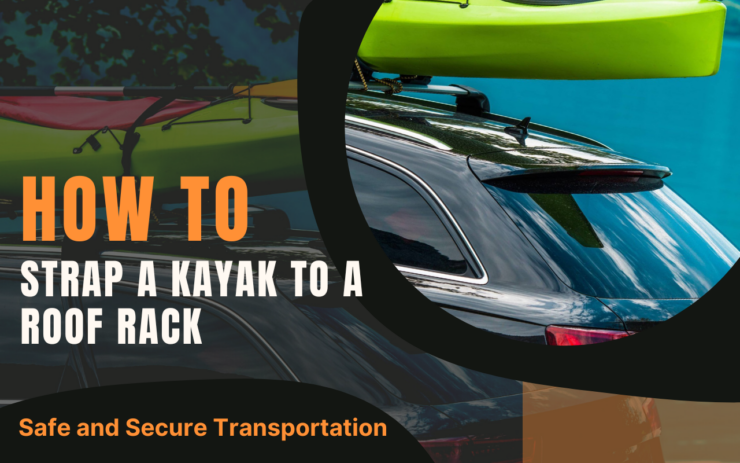There’s a magic to kayaking, a sport that’s as thrilling as it is calming. Owning a kayak opens up a world of possibilities, from enhancing your outdoor adventures like fishing, hunting, and camping to simply enjoying a peaceful paddle on your local lake.
But let’s be real, owning a kayak isn’t all smooth sailing. Sure, it’s a fantastic asset if you’re into water-based activities, but it comes with its own set of challenges. Ever tried to find a home for something that’s 9 feet long and 32 inches wide? It’s like trying to park a small whale in your living room.
Storage is just the tip of the iceberg. If you don’t have a garage or shed, your kayak becomes an outdoor ornament, requiring constant care and attention. And if you do manage to find a spot inside, you’ll need to figure out how to mount it properly on a wall or ceiling.
But wait, there’s more! The real adventure begins when you try to transport your kayak to the water. You’ll need more than just a vehicle; you’ll need ingenuity and the right equipment to get your paddling craft safely to the water’s edge. And that, my friend, is what this article is all about.
Transporting Kayaks Using Cars
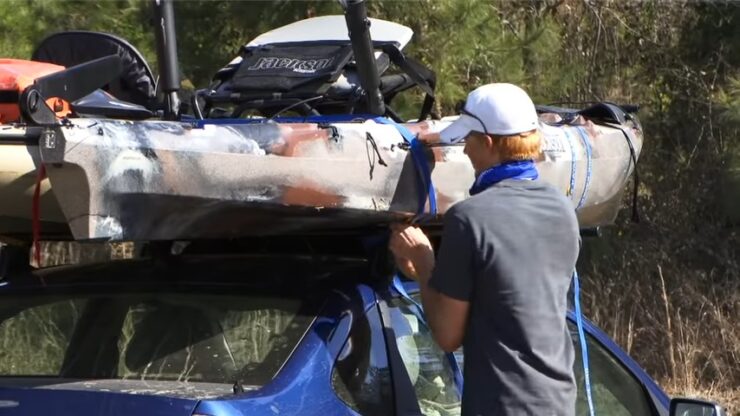
So, you’ve got a kayak and a car, and you’re ready to hit the water. Easy, right? Not so fast! Transporting a kayak is a bit like solving a puzzle, and the pieces include trailers, truck beds, rack systems, and roof racks.
Trailer Hitches
If your car’s too small, attaching a trailer hitch and using a kayak-specific trailer might be your best bet. It’s like giving your car a little tail that carries your kayak. But be warned, driving with a trailer is a whole new ball game. You’ll need to practice your turns and slow down your speed. But hey, these lightweight trailers make transporting one or more kayaks a breeze without cramping your car’s style.
Truck Beds
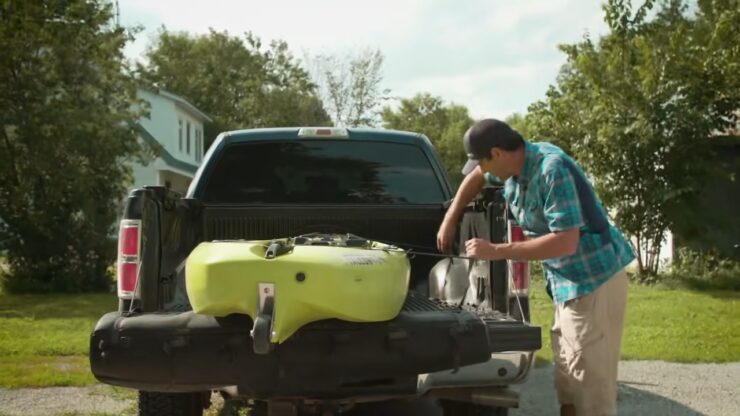
Got a pickup truck? Great! You can strap your kayak into the bed of the truck. Just make sure it’s secure, and be mindful of the size. Sometimes the tailgate has to stay open, and angling it over the back is a no-go.
Rack System
If you’re rolling in a van or RV, you might consider installing a rack system. It’s like giving your vehicle a backpack to carry your kayak. Again, securing it is key, and you’ll need a larger vehicle to pull this off.
Roof Racks
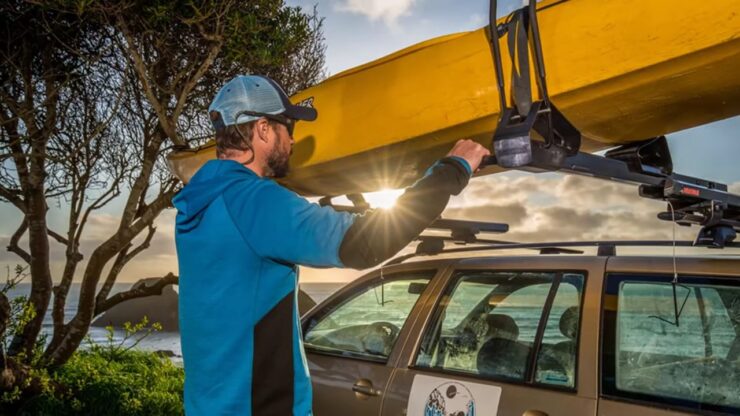
Last but not least, the star of our show, the kayak roof rack. It’s a common way to transport a kayak, but it’s not without its challenges. Lifting it, securing it, and getting used to doing it takes time. It’s always good to have a buddy to help you out.
Remember, no matter which method you choose, safety first! Make sure your kayak is secure, your vehicle can handle it, and you’re following all the rules of the road. Sometimes, you might even need to wave a red flag or flash your hazard lights to make your precious cargo noticeable.
Different Types of Kayak Roof Racks
So, you’ve got a kayak, and you’re ready to hit the water. But wait! How are you going to get it there? Enter the world of kayak roof racks. Just like kayaks and cars come in all shapes and sizes, so do roof racks. And trust me, it’s not a one-size-fits-all situation. Let’s dive into the different types of roof racks, so you can find the perfect fit for your watercraft and vehicle.
J-style Racks
Ever wonder why they call them J-style racks? It’s all in the shape. These racks have a “J” shape and cradle the kayak by its hull. They’re great for smaller vehicles, allowing you to carry the kayak upright without hogging all the roof space. Plus, you can even fit multiple kayaks in their usual position.
Saddle Racks
Saddle racks are like the cousins of J-style racks but with a more rounded shape. They hold the kayak by its entire hull, and the padding ensures a snug fit. They might not be as popular as J-hooks, and there’s often confusion between the two, but they’re versatile and can be used with different crossbar systems.
Stackers
Planning a family paddle? Stackers are your go-to. They let you stack multiple kayaks on top of each other, perfect for a larger party. Just make sure your vehicle has enough roof space; you’ll need at least a larger sedan or an SUV.
Rollers
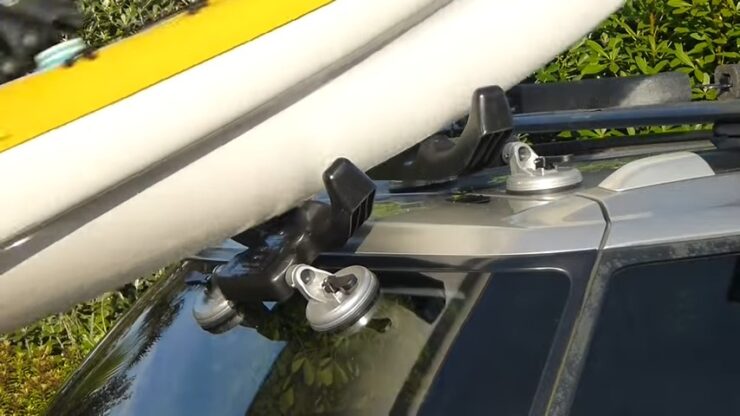
Rollers are the solo kayaker’s best friend. With rollers on top, loading and unloading your kayak becomes a breeze, and you can do it all by yourself. If you’re someone who struggles with lifting heavy objects, rollers might just be your new best friend.
Regular Crossbars
Crossbars aren’t just the place where the roof rack connects to the car; they can be the kayak rack themselves. It’s unconventional, and you’ll need to be a master of strapping and rope management, but if your vehicle already has factory-installed crossbars, you might not need anything else.
How to Strap the Kayak to a Roof Rack
Alright, you’ve got your roof rack, and you’re ready to hit the road. But how do you strap that kayak securely? Let’s break it down step by step, so you can head to the water without a worry in the world.
Tools for the Job
You’ll need some essentials: straps, padding, and buckle protection. Look for kayak-specific straps made of durable material with secure buckles. Padding, like foam blocks, will protect both the kayak and the vehicle, and buckle protectors, though optional, can prevent any rubbing damage.
Step-By-Step Guide

- Lift It Up: Get some help or slide the kayak up by leaning the front end onto the crossbars.
- Position It Right: Center the kayak, so the weight is evenly distributed. Add padding for extra comfort and protection.
- Secure It: Use straps, tie-down ropes, or bungee cords to secure the kayak. Run a strap through the kayak’s handles and scupper plugs, and tighten it just right. Repeat with additional straps in a crisscross pattern until everything is snug.
- Protect It: If needed, use buckle protectors to prevent rubbing.
- Check It: Give everything a firm wiggle and inspect regularly. Adjust as needed to keep everything in place.
FAQ
Can I transport a kayak without a roof rack?
While it’s possible to transport without a specific roof rack by using just crossbars or even padding and straps, it’s generally not recommended. Without a proper roof rack, you risk damaging both the kayak and the vehicle, and the safety of the transportation may be compromised.
How do I choose the right roof rack for my vehicle?
When selecting a roof rack, consider the size and type of your kayak, the make and model of your vehicle, and how often you plan to transport the kayak. Consulting with a professional or a specialized retailer can help you find the perfect fit.
Is it legal to transport a kayak on the roof of my car?
Yes, it’s legal to transport a kayak on the roof of your car, but you must follow all applicable laws and regulations regarding the transportation of large items. This might include marking with a red flag or using hazard lights.
How many kayaks can I transport at once?
The number you can transport depends on the type of rack and the size of your vehicle. Some racks, like stackers, are designed to hold multiple . Always refer to the manufacturer’s guidelines to ensure safe transportation.
Can I install a roof rack myself, or should I seek professional help?
While some roof racks come with user-friendly instructions for self-installation, seeking professional help ensures that the rack is installed correctly and securely. If you’re unsure, it’s best to consult with a professional.
Conclusion
Embarking on a kayaking adventure is an exhilarating experience, but getting your kayak to the water shouldn’t be part of the thrill. With the right knowledge and equipment, transporting your kayak can be a smooth and stress-free process. From understanding the different types of roof racks to mastering the art of strapping, you’re now equipped to make an informed decision that suits your needs.
Whether you’re a solo paddler or planning a family outing, there’s a solution tailored for you. So grab your paddle, secure your kayak, and head to the water with confidence. The waves are waiting, and your adventure is just a drive away. Happy kayaking!
Adelaide Gentry, a seasoned kayaking enthusiast and expert, is the driving force behind KayakPaddling.net. With over a decade of experience navigating the world’s most challenging waterways, Adelaide combines her passion for adventure with a deep knowledge of kayaking to provide insightful and practical guidance for paddlers of all levels.
Related Posts:
- 16 Best Kayak For Beginners 2024 - Kayaking Adventure Gear
- 16 Best Kayak Fishing Paddles 2024 - Affordable Fishing Gear
- Heavy Duty Fishing: 11 Best Rods And Reels For Big Fish 2024
- 15 Best Baitcasting Reel Under $100 2024 - Improve…
- 17 Best Trolling Reels 2024 - Enjoy your Fishing Adventure
- 10 Best Kayaks For Camping 2024 - Lightweight and…

